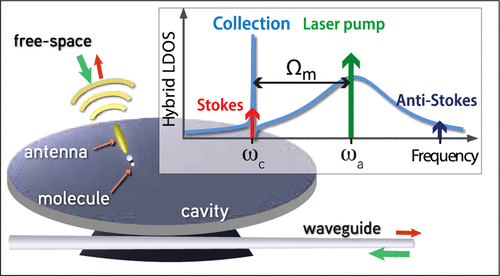当前位置:
X-MOL 学术
›
ACS Photonics
›
论文详情
Our official English website, www.x-mol.net, welcomes your
feedback! (Note: you will need to create a separate account there.)
Integrated Molecular Optomechanics with Hybrid Dielectric–Metallic Resonators
ACS Photonics ( IF 6.5 ) Pub Date : 2021-11-16 , DOI: 10.1021/acsphotonics.1c00808 Ilan Shlesinger 1 , Kévin G Cognée 1, 2 , Ewold Verhagen 1 , A Femius Koenderink 1
ACS Photonics ( IF 6.5 ) Pub Date : 2021-11-16 , DOI: 10.1021/acsphotonics.1c00808 Ilan Shlesinger 1 , Kévin G Cognée 1, 2 , Ewold Verhagen 1 , A Femius Koenderink 1
Affiliation

|
Molecular optomechanics describes surface-enhanced Raman scattering using the formalism of cavity optomechanics as a parametric coupling of the molecule’s vibrational modes to the plasmonic resonance. Most of the predicted applications require intense electric field hotspots but spectrally narrow resonances, out of reach of standard plasmonic resonances. The Fano lineshapes resulting from the hybridization of dielectric–plasmonic resonators with a broad-band plasmon and narrow-band cavity mode allow reaching strong Raman enhancement with high-Q resonances, paving the way for sideband resolved molecular optomechanics. We extend the molecular optomechanics formalism to describe hybrid dielectric–plasmonic resonators with multiple optical resonances and with both free-space and waveguide addressing. We demonstrate how the Raman enhancement depends on the complex response functions of the hybrid system, and we retrieve the expression of Raman enhancement as a product of pump enhancement and the local density of states. The model allows prediction of the Raman emission ratio into different output ports and enables demonstrating a fully integrated high-Q Raman resonator exploiting multiple cavity modes coupled to the same waveguide.
中文翻译:

具有混合介电金属谐振器的集成分子光机械
分子光力学描述了表面增强拉曼散射,使用腔光力学的形式作为分子振动模式与等离子体共振的参数耦合。大多数预测的应用需要强电场热点但光谱狭窄的共振,超出了标准等离子体共振的范围。电介质-等离子体谐振器与宽带等离子体和窄带腔模式的混合产生的 Fano 线形允许以高Q实现强拉曼增强共振,为边带分辨分子光力学铺平了道路。我们扩展了分子光力学形式来描述具有多个光学谐振以及自由空间和波导寻址的混合电介质 - 等离子体谐振器。我们展示了拉曼增强如何依赖于混合系统的复杂响应函数,并且我们将拉曼增强的表达式检索为泵增强和局部状态密度的产物。该模型允许预测不同输出端口的拉曼发射比,并能够展示一个完全集成的高Q拉曼谐振器,该谐振器利用耦合到同一波导的多个腔模式。
更新日期:2021-12-15
中文翻译:

具有混合介电金属谐振器的集成分子光机械
分子光力学描述了表面增强拉曼散射,使用腔光力学的形式作为分子振动模式与等离子体共振的参数耦合。大多数预测的应用需要强电场热点但光谱狭窄的共振,超出了标准等离子体共振的范围。电介质-等离子体谐振器与宽带等离子体和窄带腔模式的混合产生的 Fano 线形允许以高Q实现强拉曼增强共振,为边带分辨分子光力学铺平了道路。我们扩展了分子光力学形式来描述具有多个光学谐振以及自由空间和波导寻址的混合电介质 - 等离子体谐振器。我们展示了拉曼增强如何依赖于混合系统的复杂响应函数,并且我们将拉曼增强的表达式检索为泵增强和局部状态密度的产物。该模型允许预测不同输出端口的拉曼发射比,并能够展示一个完全集成的高Q拉曼谐振器,该谐振器利用耦合到同一波导的多个腔模式。









































 京公网安备 11010802027423号
京公网安备 11010802027423号